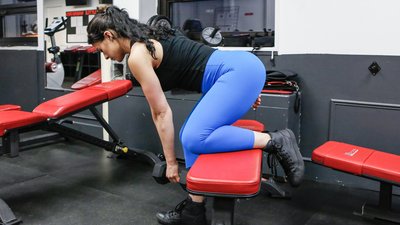You go to the gym regularly. You do your squats and deadlifts, maybe some stiff-legged deadlifts and leg extensions every now and then. You know that developing your lower body is as important as developing your upper body. Loading up the barbell truly gives you joy; you love getting stronger and watching your quadriceps, hamstrings, and glutes grow.
Occasionally, you throw in some Bulgarian split squats or lunges, but here's the thing—you're leaving a lot of strength and size gains on the table by not incorporating single-leg exercises more often.
No, you can't lift as much weight during single-leg exercises as you would with bilateral exercises, meaning with both legs, but you can take your muscle growth and symmetry to the next level with single-leg moves.
These exercises let you focus on the weaknesses and imbalances between the left and right sides. You can get the same training effect with single-leg variations, as long as the exercise is hard enough for you and you're seeing progress. Furthermore, if you have lower back issues and can't load up deadlifts or squats, single-leg exercises are your holy grail for developing the lower-body muscles.
Here are my top 10 single-leg exercises you've probably never tried, but you should. Start with body weight only on these, and then add weight. Due to the nature of the movements, your core has to work extra hard to maintain stability and proper body alignment.
Pick two exercises from each variation, add some hip abduction work, and you've got yourself a complete single-leg lower-body workout program. Always start with the weaker leg for x number of reps and match the stronger side with the same number of reps. Do 1-2 additional sets on the weaker side.
1. Bench-Supported Single-Leg Deadlift
Set one bent leg on a bench behind you and bring your working leg up against it. Be sure your hips are squared off from the start, your core braced, and your shin vertical. Just as you would with a Romanian deadlift, hinge back at the hips and lower the dumbbell or kettlebell to the ground. Feel the stretch in your hamstrings and glutes before you come back up, keeping your spine neutral throughout. This is a great variation if you struggle with balance on an unsupported single-leg deadlift.
2. Staggered-Stance Romanian Deadlift
Speaking of single-leg deadlifts and balance, the staggered stance can be another alternative when you feel that your balance is limiting the amount of weight you can use on a single-leg/glute-focused exercise. From your normal deadlift stance, bring one foot back until your toe is in line with the heel of your front foot. Keep the heel of your back foot off the ground. From here, perform a Romanian deadlift the same way you would with a normal stance, only with more of your body weight leaning into your front leg.
3. Offset-Load Deadlift
This is like performing a Romanian deadlift with dumbbells (or kettlebells), but one side at a time. The same basics apply: feet shoulder width apart, hinging at the hips with a slight bend in the knees, back nice and flat, and pushing through your heels as you lock out at the top. This not only isolates one side at a time, but also forces you to maintain a stability in your core and your pelvis. (So you don't fall over, obviously!)
4. Single-Leg Smith Machine Romanian Deadlift
If you thought Smith machine split squats were tough, your legs are in for a rude awakening. Set up as you would for a barbell squat with your shoulder blades squeezed together and a firm grip on the bar. Choose which side you'll start with, and hinge back from the standing leg while simultaneously extending the nonworking leg behind you and touching your toe on the floor before coming back to center. You should only bend at your hips, and core engagement is a must, as always!
5. Sliding Single-Leg Romanian Deadlifts
Sliders aren't a commonly used piece of equipment in the gym, but they have their benefits when you're looking to mix things up. To start, hold a plate or dumbbell on one side and place your opposite foot on a slider. As you slide your leg back, hinge at the opposite leg and keep the weight close to your body. A common mistake with this one is letting the knee on your front leg travel forward as your opposite leg slides back—remember, this is just like a Romanian deadlift (not a lunge) in that your knees should stay fixed in one place.
6. NT Loop Lateral Lunges
Here's a real burner coming at you! If you don't have an NT Loop, any resistance band will work, but make sure it's on the heavier side and challenging enough. Loop the band around something sturdy and step inside the band. Place the band above your knee joint on your outside leg. From standing, take a side step with your outside foot, fighting against the tension of the band and pushing your hips back, almost like a lateral lunge—just not going as deep. You should be feeling this in the side of your glutes, the glute medius. Keep your toes pointed forward the whole time and the shin of your working leg perpendicular to the floor.
7. Sliding Lateral Lunges
Slide your way to better glutes with this one! Place your foot on top of one slider and work one side at a time. Slide that foot out laterally and sit back into a lunge on your standing leg. At the bottom position, you should feel your upper glutes taking on more of the load, and you should feel a contraction when you slide your leg back to center.
8. Curtsy Lunge with a "Step-Through"
This starts with a sort of curtsy lunge, stepping back and slightly inward, as you can see in the video. The step-through part should be very subtle, but its purpose is to increase the glutes' range of motion and allow you to squeeze the glute hard on your standing leg.
9. Single-Leg Feet-Elevated Glute Bridge
For glute bridge variations, keep your hips even throughout the movement. A good way to check this is by touching your front hip bones and making sure they are even at the top position of the bridge—meaning, don't allow one side to drop.
10. Single-Leg Feet-Elevated Hip Thrust
The same tip from the glute bridge applies to the thrust. You may have to play around with the spacing of the two benches, but the key is to set them where you have enough room to drop your hips down and create a 90-degree angle with your knee at the top. You should be driving up with the middle of your foot or heel.
Looking for a program that will not only get your legs strong, but round out your entire physique for a great muscular base? Try Total-Body Strong, only available with Bodybuilding.com BodyFit Elite.

